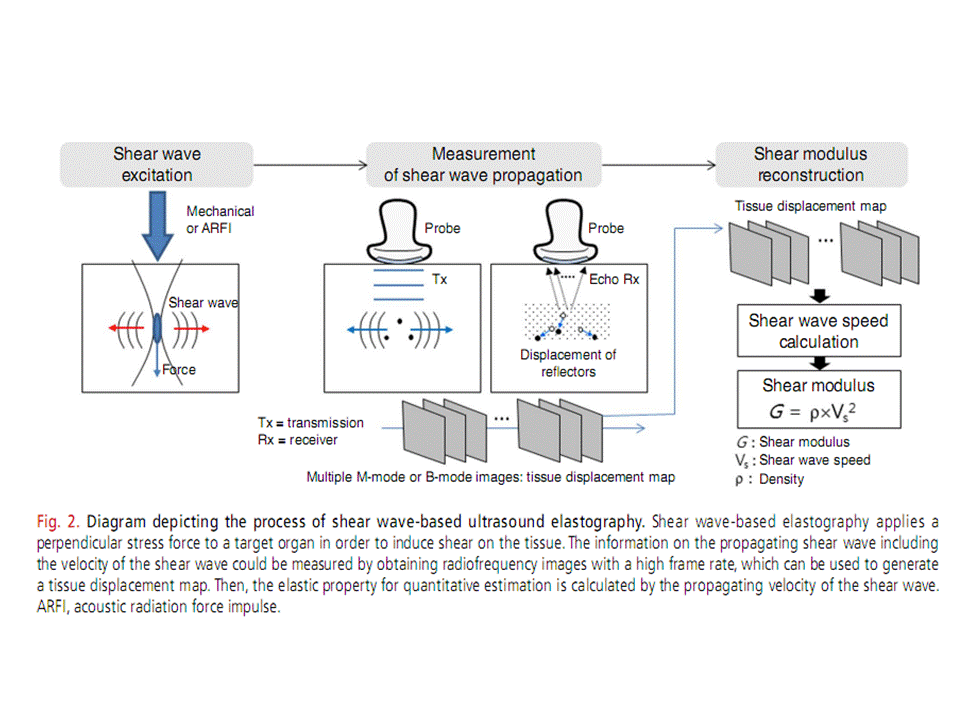US Elastography: Weaknesses and Strengths
The most significant challenge
facing US elastography is the issue of measurement reproducibility. A
number of studies concerning this issue have been published;
however, many investigators have brought up questions about this
issue due to the inherent limitations of US such as the
operator-dependent performance.
Transient elastography is a highly reproducible and user-friendly technique [45], and liver stiffnessmeasurementby transient
Transient elastography is a highly reproducible and user-friendly technique [45], and liver stiffnessmeasurementby transient
elastography does not require a learning curve:
even a novice can obtain a reliable result after a single training session
[46]. However, because liver stiffness measurements can be
influenced significantly by steatosis, obesity, lower degrees of hepatic
fibrosis [45], necroinflammation of hepatocytes [47], cholestasis
[48], elevated central venous pressure [49], and even postprandial
conditions [50], it should be carefully applied when used as an
alternative measurement of liver
stiffness instead of liver biopsy.
In the case of ARFI, the overall
reproducibility is also not bad, having an intraclass correlation coefficient
(ICC) value for the interrater observation of 0.81 and an ICC for the
intrarater observation of 0.90. However, gender (women), high body mass index,
ascites, and lower degree of liver disease (noncirrhotic patients) are
considered factors that impede the reproducibility of ARFI [51].
In the case of SSI, the inter- and intraobserver agreements have ICC values of 0.88 and 0.94, respectively, which are similar to the results of ARFI imaging [52].
In the case of SSI, the inter- and intraobserver agreements have ICC values of 0.88 and 0.94, respectively, which are similar to the results of ARFI imaging [52].
Despite the issues described
above, US elastography has many
advantages in clinical fields. The most important aspect is convenience, as is the case with
most ultrasonography examination techniques. Indeed, US
elastography is fast, easy to use, and portable, so much so that it can be
performed at the patient’s bedside. Likewise, because it does not use ionizing
radiation, US elastography is relatively safe, even in patients who repeatedly undergo
the procedure. US elastography is also less expensive than MR elastography
[53]. Going forward, the most important strength of US elastography is the
availability of a large amount of accumulated clinical data that have
demonstrated its clinical usefulness, although most of these data are related
to transient elastography.
Conclusions
Measurement of liver stiffness
using various technical developments is evolving to overcome its limitations.
Recently, the European Federation of Societies for
Ultrasound in Medicine and Biology (EFSUMB) published an informative
guideline for the use of US elastography [54,55] that deals
with the relevant technology and clinical applications. Along with
the basic principles for use, these guidelines include the practical
advantages and disadvantages of US elastography as well as
recommendations for the examination of various body parts. According to
these guidelines, US elastography is useful to assess the severity of
liver fibrosis in patients with diffuse liver disease and particularly to
distinguish patients with nil to mild fibrosis from those with significant
fibrosis, although some of the newer techniques must be
validated through clinical studies. At present, however, US elastography
for the differentiation of focal hepatic lesions is not
recommended.
In conclusion, US elastography is
useful for diagnosing hepatic fibrosis in patients with CLD and may be used as
a convenient and non-invasive surveillance method to estimate the prognosis of
patients with fatal complications related to CLD. Accordingly, the development
of a standardized method for liver stiffness measurement and technical
improvements should be a priority for the clinical application of US
elastography. Together, these efforts will significantly enhance the clinical
implications of US elastography.





